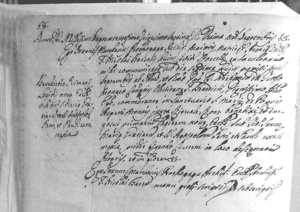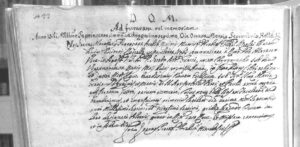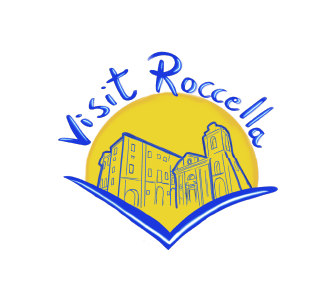translated with AI
From the book “Churches of Roccella Jonica,” Gangemi Editore, 2006, pp. 270-271:
“On the left bank (note: right bank of the river if facing away from the source) of the Zirgone stream, hidden and protected by the rich Mediterranean vegetation and the massive sides of the cliff on which the ancient city stands, lies the complex of the Sanctuary, accessed by a staircase that, despite modern interventions, still retains its original eighteenth-century features.
The façade, crowned by a pediment with a volute pinnacle, is articulated into two decks of different heights, marked by a frieze, and is divided into three parts by groups of four pilasters that continue into the pediment. Above the pediment cornice, extending from the pilasters, there are remnants of masonry, perhaps bases or attachments for other decorations no longer existing or never realized. The central axis of the façade is defined, from top to bottom, by a small blocked oculus, an octagonal window, and the stone portal, consisting of a molded band framing the entrance, above which protrudes a cornice, probably the only remains of a now disappeared frieze, on which two volutes conclude the portal. On the right side façade, traces of two blocked windows can be noticed, albeit with difficulty. The building has a single nave covered with a barrel vault, separated from the semicircular apse, evident on the outside, through a triumphal arch. The walls are marked by pilasters with composite capitals framing shallow niches”.
According to oral tradition, the church was founded in 1545 as a thanksgiving for a miracle. It is said that the crew of a boat caught in a storm off the coast of Roccella invoked the help of the Madonna, who promptly intervened by lifting the boat from the waters and placing it on the shore near the mouth of the Zirgone stream. In gratitude for the grace received, the faithful of the Roccella community affectionately call her Madonna della Grazia. However, archival and bibliographic sources indicate that originally the church was dedicated to Saints Peter and Paul. The first documented mention found in the Archives of the Diocese of Locri-Gerace reads: “Iacobo, als Iacobello Manfrè, clerico Hieracen… qui resignavit in manibus Ordinari ecclesiam S. Petri, prope et extra muros terrae Roccellae…” (Reg. Lat. 1823, f. 324-328). This original dedication is also evidenced by the presence of two alabaster figures dating from the late 15th to early 16th centuries depicting the two Apostles and placed on either side of the entrance. In the following decades, there are several written testimonies confirming the following designation: “Church of St. Peter and Paul and Most Holy Mary of Graces.”
The cult of Madonna delle Grazie was also present in the Mother Church of San Nicola di Bari, next to the Castle, since December 18, 1650, with the establishment of a chapel dedicated to Her along with Saint Victor Martyr of the patronage of the Coluccio family arranged on the left wall, entering from the main door. The presence of the two divinities is constant in Roccella, as can be seen from the large, finely crafted painting displayed in the apse of the Church of San Nicola ex Aliph, dating back to 1667. This underscores the great devotion that the people of Roccella have always shown towards Saint Victor and the Madonna delle Grazie. Another testimony of this faith, manifested by the entire Roccella community, is found in the citation of Monsignor Del Tufo when in 1737 he blessed all the bells of Roccella. This reference is reported in a Platea of the church of San Nicola di Bari from 1740. The following inscription is read: “The large (bell), weighing around 1000 pounds of metal, in which is carved… St. Victor, protector on horseback in the act of pursuing the Barbarians among which Enterprises the Image of the Most Holy Virgin Mary of Graces, with the Verses St. Maria Ora pro nobis…” In 1730, the church is still mentioned under the title of St. Peter but inside it housed an image of Madonna delle Grazie, placed there out of devotion.
In the minutes of his pastoral visit, Monsignor Idelfonso Del Tufo, which took place on June 18, 1737, noted the precarious state of the church, reaffirming the need for its restoration. It was precisely the strong devotion to Madonna delle Grazie by the people of Roccella that led to the decision to build, next to the pre-existing one dedicated to the Apostles Peter and Paul, a new church in the current form that we know.
This document, found in the historical archive of the Diocese of Gerace-Locri, attests to the laying and blessing of the first stone for the construction of the new church, which took place on September 9, 1737.

Anno Domini Millesimo Septincentesimo Trigesimo Septimo, Die Decima mensis Septembris …
Ego Joannis Marchesius Prothopapa, Archip. Majoris Matricis Archip. Eccles. S Nicolai Barensis huius civit.s Roccelle ex facultate mihi communicata sub die septima huius premissi mensis Septembris ab Illustrissimus et Reverendissimus Vescovo Don Idelfonso Del Tufo Monaco Canonis Olivetano S. Benedicti, Dignissimo Hieracen Episcopi commorante in Santuario S. Marie de Populis Asperimontis iuxta Rituale Romito benedixi et imposui primariam lapidem novae Eccle. Sub titulo Sanctae Mariae Gratiarum, et SS. Apostolorum Petri et Pauli extra moenia, pridie figendo Crucem in loco designatis Altaris, et in fidem.
Ego Joannes Marchesius Prothopapa Archip. Eccl. Archipresbite S. Nicolai Barens. manu prop. scripsi et subscripxi.
TRANSLATION
In the Year of Our Lord 1737, on the tenth day of the month of September, I, Giovanni Marchese Protopapa, Archpriest of the Archpriestal Mother Church of St. Nicholas of Bari in this city of Roccella, have the authority to communicate that on the seventh day of this month, announced by the Most Illustrious and Most Reverend Bishop Don Idelfonso Del Tufo, Olivetan Monk of the Rule of St. Benedict, Most Worthy Bishop of Gerace, residing in the Sanctuary of St. Mary of Polsi in the Aspromonte justly, I blessed and laid the first stone of the new Church under the title of Santa Maria Delle Grazie, and of the Holy Apostles Peter and Paul outside the walls, the day before fixing the Cross in the place indicated for the Altar, and in witness thereof, I, Giovanni Marchese Protopapa, Archpriest of the Archpriestal Mother Church of St. Nicholas of Bari, wrote and subscribed with my own hand.
The internal decoration was also part of the project, including stuccos on the frames, the canopy above the main altar, and the statues of the two Apostles in the apse, which, according to scholars and confirmed by inscriptions found during the latest restoration work, were crafted by the Palermitan stucco artist Onofrio Buscemi, a renowned artist of that era who also worked on numerous other projects in different churches of Calabria. The stuccos appear to have been retouched and repainted over the years, as evidenced by the background of the statue of St. Paul, where the head of the angel has been covered by a cloud background. Bishop Del Tufo’s pastoral visits to Roccella were frequent, indicating that the illustrious prelate, like all the faithful of this community, cared deeply about the construction of the new church. During his visit on May 30, 1739, he noted that the sacred building was progressing well and that, for its completion, the door was needed. Furthermore, the main altar was dedicated to St. Maria delle Grazie, whose custody was to be entrusted to a hermit.
In the subsequent visit on June 27, 1742, it is noted that the completion of the sacred building was still not progressing well. Finally, as evidenced by the record of November 9, 1743, by Bishop Del Tufo, the work was practically nearing completion: “We found the new church erected up to the vault; we praise the People for their diligence and we command to build windows which are now lacking, and to make two larger lateral ones, so that they may render it more luminous”. Furthermore, this document highlights the great demonstration of faith of the population towards the Virgin Mary of Graces and the intention to improve the brightness of the church.
Meanwhile, the cult of the Holy Apostles was diminishing more and more, and finally, with the completion of the works, the long-awaited blessing of the church was celebrated with great participation of the faithful and civil and ecclesiastical authorities. The ceremony, held on September 8 (the Feast of the Nativity of the Blessed Virgin Mary) in 1747, was officiated by the Archpriest Don Giovanni Marchese, authorized by the Apostolic Vicar Alvarez and assisted by the Reverend Clergy of Roccella.

D.O.M.
Ad futuram rei memoriam
Anno Domini Septicentesimo quadragesimo septimo, die octava Mensis Septembris Roccellae
Nos Joannes Marchesius Protopapa archipresbiter Maioris Matrisque Archipresbiter ecclesie S. Nicolai Baren. huius civitatis Roccelle ex facultate Nobis communicata ab Ill.mo Domino Alvarez vicario apostolico U.J.D. et D. Jacobo abbate Guacci, ut ex chirographo sub die vigesima octava mensis maij huius praemissi anni, in fine huius libri colligato, iuxta Apostolicam auctoritatem benediximus novam Ecclesiam sub titulo Sanctissimae Mariae Gratiarum Virginis et Matris ac Sanctorum Apostolorum Petri et Pauli exta moenia aedificatam iuxta parvam veterem, cuius novae ecclesiae Nos ex facultate vero benediximus et imposuimus primam lapidem die decima mensis septembris anni millesimi trigesimi septimi, pridie figendo crucem in loco designati altaris, prout in ritu ipso et missam cantavimus et in fidem Dei gratia
Joannes Marchesius Protopapa archipresbiter.
To the Most Excellent and Supreme God
For Future Memory
TRANSLATION
In the year of our Lord 1747, on the 8th day of the month of September, in Roccella. We, Giovanni Marchese, Protopriest and Archpriest of the Major Church and Archpriest of the Church of St. Nicholas of Bari in this city of Roccella, following the authority granted to us by the Most Illustrious Mr. Alvarez, Apostolic Vicar and Doctor in both laws, and by the Abbot S. Giacomo Guacci, as per the handwritten document dated May 28 of the same year and attached at the end of the book, according to apostolic authority, blessed the new church under the title of Santa Maria delle Grazie, Virgin and Mother, and of the Holy Apostles Peter and Paul, built outside the city near the old ancient church. And we ourselves, in accordance with the authority received, blessed and laid the first stone on the 10th day of September 1737, first placing the cross in the designated place for the altar, and according to the ritual, we sang the mass and in testimony giving thanks to God.
Giovanni Marchese, Protopriest and Archpriest
In the following decades, the church retained its ancient denomination: “under the title of Mariae Gratiarum ac Principum Apostolurum…” but from the first half of the 19th century, there are several written testimonies that highlight only this title: “Countryside Church of Most Holy Mary of Graces where this single altar which constitutes the title…” (from a report drafted by Archpriest Bova on May 19, 1837).
Around 1840-45, the aforementioned Church was also destined to serve as a cemetery in support of the construction of the cemetery in the Botta district, next to the Zirgone stream. The construction work was well underway when new provisions arrived, which halted the progress of the work, deeming the cemetery inadequate and unsuitable in that location.
Almost certainly, it was between the late 19th and early 20th centuries that the sacred building, from a simple church, became a Sanctuary, as it was exclusively dedicated to the Madonna delle Grazie. Inside it is preserved, protected by a wooden case, the statue of the Blessed Virgin, of which, according to experts and oral testimonies, the author is the sculptor Antonio Spina from Mammola. The feast takes place on the first Sunday of July. In the past, when there was no road yet, the procession wound along the bed of the Zirgone stream, and the Madonna was hosted in the church of San Nicola ex Aliph. Today, however, she is accompanied to the new Mother Church. The number of faithful, many of whom are outsiders, becomes larger on Sundays when the Madonna becomes the protagonist of an evocative sea procession, followed by numerous boats. Today, the sea route has become longer, as the simulacrum of Maria Ss.ma delle Grazie is brought into the port dedicated to Her. The worship, love, and devotion of the people of Roccella towards Her have been well expressed by Don Simone Molinero in his brief publication of 1968:
“Since then (since the miracle occurred), devotion to the Madonna delle Grazie, Patroness of Roccella and Patroness of emigrants, sailors, and fishermen, validated by numerous graces and miracles, spread everywhere in Calabria and beyond. The Feast is celebrated every year on the first Sunday of July, with a truly moving love, solemnity, and enthusiasm. The entire population of Roccella moves to celebrate the Celestial Patroness, with prayers and songs. The honor of carrying the statue of the Madonna in procession is reserved for the fishermen, and one must see how well they do things: they are old and young sailors, but around their Madonna, they seem like joyful children, jealous and proud of their Celestial Mother. There may be people advising them to be calm and prudent, but no one can make them give up the most beautiful and moving part of the procession. They must run up the steep climb and long staircase of the sanctuary. When they reach the beginning of the ascent, they stop and prepare with religious silence, feeling and being proud to perform almost a sacred rite in honor of their Protectress. Then… at a signal, almost with a wild cry, they start, and… off they go, carrying their dear Madonna. The thousands of faithful who have witnessed the preparations, holding their breath almost, but unable to hold back the tears and the emotion of the heart, now echo the cry of the sailors, who, when they reach the end of the small square, repeatedly raise, with joy, with pride, and with love on their arms, the dear image of the Madonna, who smiles and blesses”.
“O Mary, how beautiful you are!
You are joy and you are love…”
This is the chorus of greeting that bursts from thousands of hearts to the Madonna delle Grazie, who, from her secluded sanctuary, always turns her maternal gaze to the sailors, to the emigrants scattered in all parts of the world, and above all extends her protective and blessing hand.
Maria Ss.ma delle Grazie is always in the hearts of her people from Roccella, even those who, for work reasons, have had to emigrate to distant lands, particularly in Argentina and Australia: there they organize celebrations in honor of the Madonna together with the other Patron Saint, San Vittorio Martire, and the occasion falls on November 25th every year.
